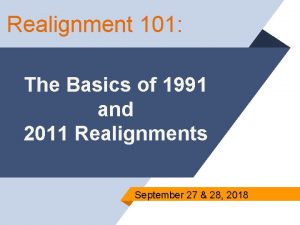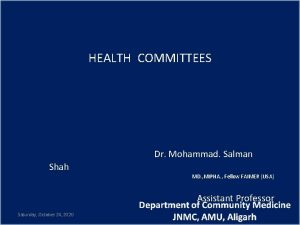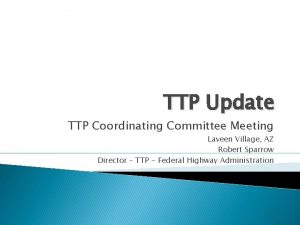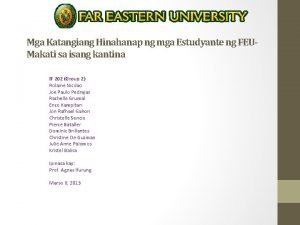MGA Strategic Planning Committee Alternative for Realignment of













- Slides: 13

MGA Strategic Planning Committee Alternative for Realignment of the Regions REGION REALIGNMENT: A subset of the MGA Strategic Planning Committee, chaired by Vice President-Elect Kukjin Chun is looking at the Region structure with regard to the vastly different sizes of regions. The Committee is looking at whether the current structure adequately represents the diverse membership of IEEE and is considering alternatives. Focus to date has been on alternatives to current Regions 8 and 10 structure. Several options are under consideration. Further work is continuing. 1

Region Realignment Assumptions: 1. The number of regions and the number of divisions should remain equal. 2. How to combine regions or partial regions should be determined by the organization itself. (e. g. US directors) 3. We should bring R 7 and R 9 into the discussion to see if they would like to combine with any US or other region. 4. How to break up regions should be determined by affected regions (e. g. Regions 8 and/or 10) 5. Any changes to region structure should be respectful of country boundaries and take into account cultural sensitivities. 6. The changes will have to be phased in over several years because volunteers have already been elected to these positions. A transition plan will be needed. 7. There may still be very small regions (in member numbers) but large geographically, such as regions 7 and 9, unless they wish to be combined with part of another region. 8. Consider future growth in this study. 2

Options for Region 10 ▶ Two Type of Options 1. Split current Asia-Pacific Region into two Regions without adding any more organizational unit (OU) from another Region 2. Split & Merge parts of R 10 and R 8 to create a new Region and thus reduce the sizes of both existing Regions. 3

R 10 Split (Option# 1) North Asia 54% South. Asia/Pacific 46% Voting Members (Data December 2018) Ø North Asia: 47, 137 Ø South Asia & Pacific: 40, 417 4

R 10 Split (Option# 1) ▶ • The new South Asia & Pacific Region will remain a diverse Region. • • 5 Pros: ▶ Cons: • Considerable improvement in the representation of current R 10 membership at the Assembly by the Directors/Delegates of two Regions. Even with a slightly bigger slice of R 10, the North Asia Region will not be as diverse as current R 10 or the new South Asia & Pacific Region. • Both Regions will be able to continue joint activities such as R 10 flagship conferences and the annual Region’s Committee meeting. One Region may not be financially as beneficial to the IEEE as the other and may result in unequal growth opportunities for one or both Regions. • Risk of domination of one or two larger countries (membership-wise), especially in the South Asia/Pacific Region. However, appropriate Regional Bylaws may address this issue. • Does not address the same problem faced by other Regions, namely R 8 and R 9.

R 10 Split (Option# 2) Voting Members (December 2018 data) ▶ Asia: 38285 ▶ Pacific: 57554 6

R 10 Split (Option# 2) ▶ 7 Pros ▶ Cons • Split of R 10 into Asia and Pacific Regions will not unfavorably affect the diversity of either part. • Not helpful to R 8 with same the problem of large membership and vast geographical spread. • All ASEAN countries with close working relations and ease of travel will remain in one IEEE Region, namely Asia Region. • • Both new Regions will be able to continue to work jointly on technical and administrative activities of current R 10, e. g. flagship conferences (TENCON, TENSYMP and R 10 HTC), annual regional committee meetings and Students/YP/WIE/LM Congress. • No “cultural shock” of joining countries with new and very different culture and customs.

Split & Merge (Option# 3) R 10 (Southwest Asia) 69% R 8 (ME, CA & Africa) Membership % from R 8 and R 10 31% joining the new region Voting Members (December 2018 data) ▶ 8 Africa, Middle East, Central and South Asia 33, 929 ▶ East Asia & Pacific 59, 134 ▶ Europe 51, 492

Split & Merge (Option# 3) ▶ Pros: • A new culturally diverse Region with potentials for growth. • A reasonable membership figure for the Regional Director/Delegate to represent at the IEEE Assembly. ▶ Cons: • This option will create another large and • • 9 ▶ Cons (continued): • Difficult to manage the whole Region by the Director/delegate from a far-flung country in a different continent. • It is anticipated that African part of the Region will continue to need support from more experienced Asian part to grow, which may not be as practical as the existing long running arrangements by R 8. very diverse Region and will defeat the purpose of Regional realignment for better representation of membership segments by • IEEE membership in African a Regional Director. countries is not as high as the It will be difficult for the Asian part to Southwest part of R 10 and is also a maintain close working relationship with its bit patchy across a larger number previous limb. of countries with not many fast The dissimilarities in social and cultural way growing Sections. This may result in a significant financial drain at the of life will result in less understanding of members needs across the Region and thus cost Asian part of the Region. diversity will become a disadvantage for the new Region.

Split & Merge (Option# 4) Asia 88% ME & CA 12% Composition of the new region Voting Members (December 2018 data) 10 ▶ Pacific Region: 57, 285 ▶ Asia Region: 42, 634 (37, 531+4, 961)

Split & Merge (Option# 4) ▶ • Potentially beneficial for members in more than one IEEE Regions with substantial improvement in representation of membership segments at the Assembly with an additional Director/Delegate from the Asian side of the globe. • Merger will not experience a big “cultural shock” by the two merging parts from R 8 and R 10. • Common cultural and social systems across the new Region will make it relatively easier to be fully functional and effective in a short period. • 11 Pros New region will find it easier to maintain close relationship with R 8 and R 10 and hence possibly serve as a bridge for enhanced inter-regional collaboration. ▶ Pros (continued) • May enhance employment opportunities for engineers graduating in the Asian part of the Region (South Asia and Far East). • The leftover Region 10 will remain as the Asia-Pacific Region and maintain its diversity by covering Northeast Asia (China, Japan, Korea and Mongolia) and Pacific countries (Australia, New Zealand, Cambodia, Vietnam, Philippines and other Pacific island countries). ▶ Cons • Concentration of large IEEE Sections (membership >1500) in only one country, namely India with few exceptions such as Malaysia and Singapore in the newly formed Asian region. • • ASEAN countries are divided into two. No major technologically advanced country in the newly formed Asian region.

Split & Merge (Option# 5) R 10 82% R 8 18% Composition of the new region Voting Members (December 2018 data) 12 ▶ Pacific Region: 55, 989 ▶ Eurasian Region: 46, 699

Split & Merge (Option# 5) ▶ 13 Pros ▶ Cons • ASEAN countries, which have close connections, are together. Similarly CIS (former Soviet Union) countries are together. • The proposed Eurasian Region will be geographically very large with more than 40 countries in the Region. • Director/Delegate representing a reasonable number of members at the Bo. D. • Difficult to manage by the Region’s Director/Delegate from a far-flung country. • A culturally very diverse region close to both R 8 and Pacific Region. • The diversity will most like becoming a weakness instead of strength.
 1991 realignment
1991 realignment Apex distance is given by formula
Apex distance is given by formula Strategic planning vs tactical planning
Strategic planning vs tactical planning Sjacl
Sjacl Planning alternative tomorrows with hope
Planning alternative tomorrows with hope Planning alternative tomorrows with hope
Planning alternative tomorrows with hope Mipha in medical
Mipha in medical Laveen village planning committee
Laveen village planning committee Pagdakip sa mga manunulat na bumabatikos sa mga amerikano
Pagdakip sa mga manunulat na bumabatikos sa mga amerikano Pag aalsa ni lakandula
Pag aalsa ni lakandula Strategic fit vs strategic intent
Strategic fit vs strategic intent Strategic complements definition
Strategic complements definition Resource based model
Resource based model Strategic analysis and choice in strategic management
Strategic analysis and choice in strategic management

























